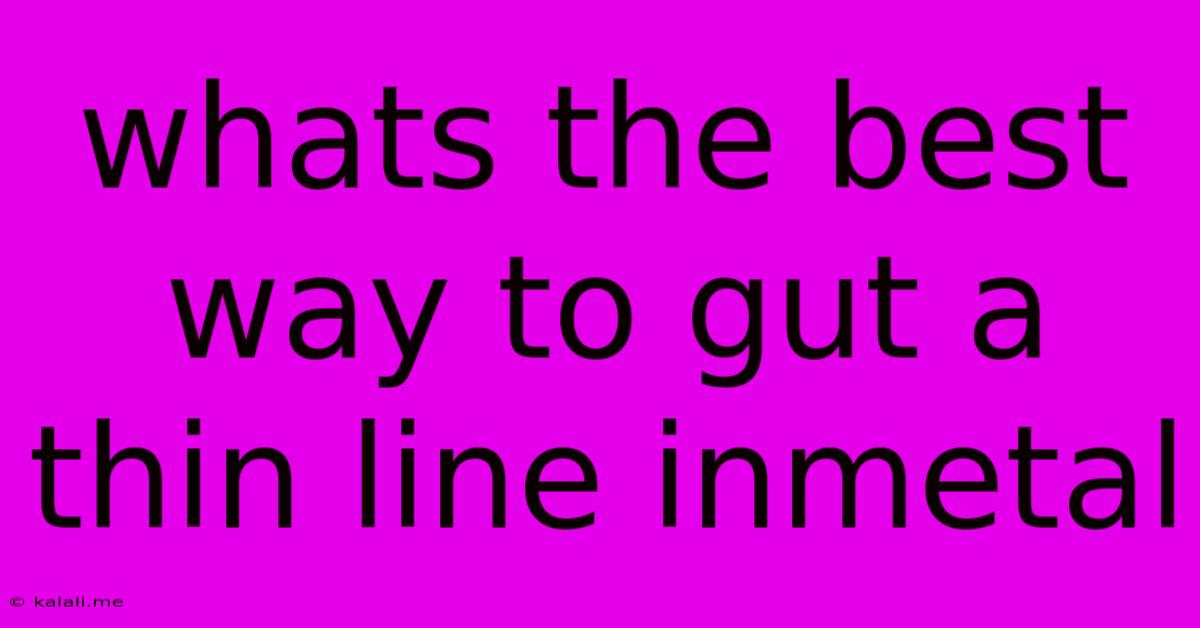Whats The Best Way To Gut A Thin Line Inmetal
Kalali
Jun 03, 2025 · 3 min read

Table of Contents
The Best Way to Cut Thin Metal Sheet: A Comprehensive Guide
Cutting thin metal sheets cleanly and precisely can be challenging. Whether you're a seasoned metalworker or a DIY enthusiast, achieving a smooth, burr-free edge requires the right technique and tools. This guide explores the best methods for cutting thin metal, comparing their pros and cons to help you choose the optimal approach for your project. We'll cover everything from selecting the appropriate tools to mastering the cutting process itself, ensuring you get the best possible results.
Why Precision Cutting Matters
Precise cuts are crucial for various reasons: they ensure proper fit and function in your project, minimize the need for post-processing like filing or sanding, and ultimately save you time and effort. A clean cut also enhances the aesthetics of your finished product, giving it a professional look. Choosing the right cutting method for your specific metal type and thickness is key to achieving these outcomes.
Choosing the Right Tool for the Job
Several tools excel at cutting thin metal sheets. The best choice depends on factors like the metal's thickness, the desired cut quality, and your budget. Here's a breakdown of popular options:
1. Aviation Snips: These hand-operated shears are excellent for intricate cuts and curves in thinner gauge materials (up to around 20 gauge). They come in different styles – left-hand, right-hand, and straight – allowing you to tackle various cutting angles and geometries. Aviation snips offer great control and are relatively inexpensive.
Pros: Affordable, precise control, good for curved cuts.
Cons: Can be tiring for large cuts, not suitable for thicker metals.
2. Tin Snips: Similar to aviation snips, tin snips are designed for cutting thin sheets of metal, particularly softer metals like tin or aluminum. They often feature a shorter blade length compared to aviation snips.
Pros: Inexpensive, good for straight cuts in thinner materials.
Cons: Limited in terms of cutting thicker metals or complex curves.
3. Rotary Cutters: Using a specialized rotary cutter with a sharp carbide blade designed for metal cutting can provide excellent results on thin sheets. This method offers speed and efficiency, particularly for straight cuts. Ensure you use a cutting mat to protect your work surface.
Pros: Fast, clean cuts, suitable for straight lines.
Cons: Requires a specialized cutter, may not be ideal for curves.
4. Shear: For thicker gauge sheet metals or when cutting straight lines with high precision is paramount, a mechanical shear is the ideal choice. These tools are robust and can handle heavier-duty cutting tasks.
5. Laser Cutter: For complex designs, high precision, and automated cutting, a laser cutter is unmatched. However, it represents a significant investment and requires specialized training.
6. Nibbler: A nibbler uses a punch-like action to remove small pieces of material, creating a series of small holes that form a cut. This method is suitable for both straight and curved cuts, even in thicker sheet metals, but is slower than other methods.
Tips for a Clean Cut
Regardless of the tool you choose, follow these tips to ensure a clean and precise cut:
- Secure your material: Use clamps or a vise to hold the metal firmly in place to prevent slippage and ensure a straight cut.
- Use sharp blades: Dull blades will create ragged edges and increase the risk of bending the metal. Regularly sharpen or replace your blades as needed.
- Support the metal: Avoid letting the metal sag during cutting, which can lead to unevenness and inaccuracies. Support the metal sheet underneath the cut area.
- Maintain consistent pressure: Apply even pressure throughout the cutting process to achieve a smooth, consistent cut.
- Practice: The more you practice, the better you'll become at controlling the tool and achieving clean cuts.
Conclusion
Cutting thin metal sheets efficiently and accurately requires the right tool and technique. By carefully considering the metal's thickness, the complexity of the cut, and your budget, you can select the best approach for your project. Remember to prioritize sharp blades, secure work holding, and consistent pressure for optimal results. With practice and the right tools, you'll achieve professional-quality cuts every time.
Latest Posts
Latest Posts
-
Can I Write Stealth Startup Internship In My Resume
Jun 05, 2025
-
What Is The Difference Between Rallentando And Ritardando
Jun 05, 2025
-
Can I Cook 2 Hams At The Same Time
Jun 05, 2025
-
How Do You Say Later On In Spanish
Jun 05, 2025
-
6 Year Old Not Listening At School
Jun 05, 2025
Related Post
Thank you for visiting our website which covers about Whats The Best Way To Gut A Thin Line Inmetal . We hope the information provided has been useful to you. Feel free to contact us if you have any questions or need further assistance. See you next time and don't miss to bookmark.